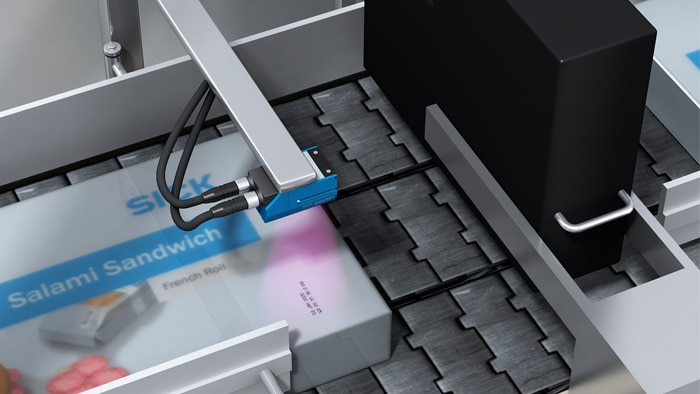A groundbreaking collaboration between SICK and AutoCoding Systems has resulted in the launch of the first fully-automatic smart vision inspection system for printed coding and marking on food, pharmaceutical and other consumer goods packaging.
4Sight Automatic Print Inspection System with SICK AppSpace “gets the message”
The 4Sight Automatic Print Inspection System achieves significant savings in day-to-day production stoppages for producers. A breakthrough innovation achieved in the AutoCoding 4Sight software, operating on SICK’s InspectorP 2D vision camera, enables direct closed-loop communication of the printed message from any brand of printer using standard inkjet, laser or thermal transfer technologies.
High-speed inspection system for printed codes
Working with SICK and using the power of the SICK AppSpace development environment, we were able to draw on the strengths of AutoCoding to think about print inspection systems in a completely new way,” explains Mike Hughes, Managing Director of AutoCoding Systems. “The result is a directly networked connection between the printer and the 2D vision camera, coupled with the 4Sight software’s unique ability to self-optimize the code inspection process. As the artificial intelligence is already pre-trained in the application, the AutoCoding system knows exactly the printed message it is looking for. So, the system adjusts automatically when the printer changes to a new job. There’s also much more opportunity to finesse the vision inspection criteria and avoid unnecessary line stops, because there can be no false reads as a result of the packaging background, or due to natural variation in the location of the printed code.
Flexibility with ‘good read, bad read or no read’ on a per product basis
Powered by SICK AppSpace, on board the high-resolution SICK InspectorP 2D vision camera with no need for a lineside PC, the 4Sight software simultaneously checks whether the printed code is correct, present and legible. Users have the flexibility to define what is classed as a ‘good read, bad read or no read’ on a per product basis. However, there’s no need to teach fonts, configure features or regions of interest on the packaging, or for fixturing against an edge or logo. A simple, user-guided self-set up process configures the optimal camera settings.
Processing inspection images with extremely short cycle times
Enabled by the high-resolution and processing power of SICK vision technology, the solution is capable of processing inspection images with extremely short cycle times. It operates at increasing line speeds, including high-speed applications such as bottling and canning lines. The 4Sight Automatic Print Inspection System can be set up as a stand-alone system using all main printer brands, as well integrating with proprietary code deployment systems. It can be configured to connect with other devices, for example an encoder, and can be integrated with other systems e.g. to control a rejection system. The solution is able to provide full diagnostic reports and event logging and will store and forward inspected images to the customer’s network location of choice. Feasibility studies, installation, integration, training and ongoing support are available through AutoCoding Systems.
Neil Sandhu, SICK’s UK Product Manager, Imaging, Measurement, Ranging & Systems added: “All too often we are called in to help production teams who have ended up disabling their vision systems altogether because of the nuisance caused by frequent, unnecessary line stops as a result of an overly-sensitive system. The problem is too complex for the operators to fix, so the vision system simply becomes a white elephant. As a result, the manufacturer remains at risk of receiving penalties and damaging their customer relationships if code inspections on delivery result in products being returned. That’s why the 4Sight system is such an important breakthrough, because it offers a high-performance, dependable solution that’s easy to set up and use.”
Video: SICK AppSpace – engineering framework for your individualized sensor applications
Detlef Deuil
Head of Product Management en productos de integración vertical
Como jefe del área de Product Management en Productos de integración vertical, Detlef Deuil es responsable en SICK, entre otras cosas, de la introducción en el mercado de productos relevantes para la industria 4.0. Entre ellos se encuentra el ecosistema SICK AppSpace, que permite la programación de aplicaciones personalizadas directamente en el sensor, así como la Sensor Integration Machine (SIM). Esta fusiona los datos de sensores y cámaras, los evalúa y permite su transmisión a la nube.






